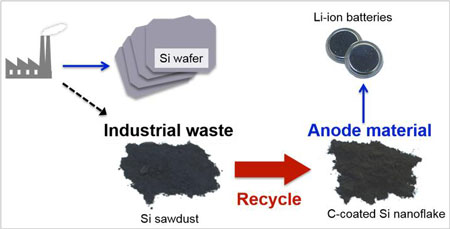| Posted: Feb 21, 2017 |
Waste silicon sawdust recycled into anode for lithium-ion battery
(Nanowerk News) Researchers have created a high performance anode material for lithium-ion batteries (LIBs) using waste silicon (Si) sawdust (Scientific Reports, "Beads-Milling of Waste Si Sawdust into High-Performance Nanoflakes for Lithium-Ion Batteries").
|
 |
| This is a production process from silicon sawdust to lithium battery anode. (Image: Hirotomo Nishihara)
|
|
It is energy-consuming and expensive to produce Si wafers with high purity (> 99.99%). On top of that, some 50% of Si is actually discarded as industrial waste in the final cutting process. This waste is about 90 thousand tons a year worldwide, an amount large enough to meet the global demands for anode materials for LIBs.
|
|
To make this happen, under the project of "Dynamic Alliance for Open Innovation Bridging Human, Environment and Materials," a joint research team from Tohoku University and Osaka University has developed a practical and mass-producible method of recycling the unwanted Si sawdust into a high-performance anode material for LIBs.
|
|
The team found that the pulverization of the Si sawdust into Si nanoflakes (~16 nm in thickness) and the subsequent carbon coating are effective in fabricating high capacity and durable LIBs. So far, a test half-cell has achieved a constant capacity of 1200 mAh/g over 800 cycles. This capacity is 3.3 times as large as that of conventional graphite (ca. 360 mAh/g).
|
|
The proposed method of material recycling is applicable for the mass production of high-performance LIB anode materials at a reasonably low cost. The research team expects that it will have great practical use in the battery industry.
|

